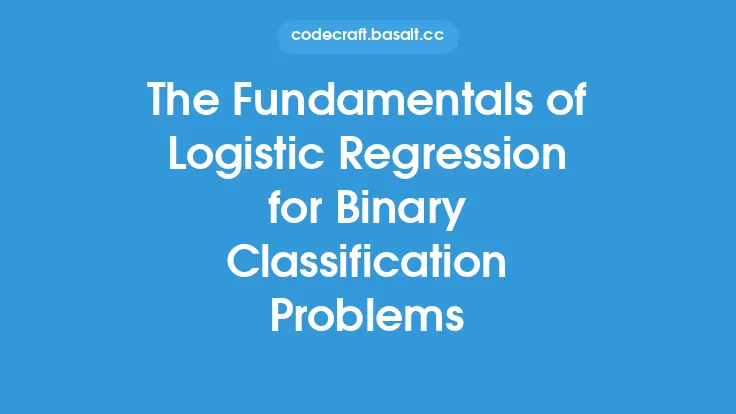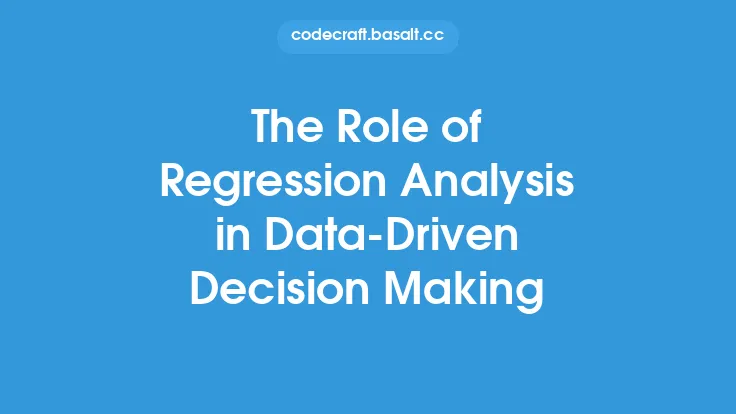Logistic regression is a fundamental algorithm in machine learning, particularly in the realm of binary classification problems. It is a widely used and well-established method for predicting the outcome of a categorical dependent variable based on one or more predictor variables. In this article, we will delve into the basics of logistic regression, exploring its underlying principles, mathematical formulation, and application in binary classification scenarios.
Introduction to Logistic Regression
Logistic regression is a type of supervised learning algorithm, which means it learns from labeled data to make predictions on new, unseen data. The primary goal of logistic regression is to predict the probability of an event occurring, such as 0 or 1, yes or no, or positive or negative. This is achieved by modeling the relationship between the predictor variables and the target variable using a logistic function, also known as the sigmoid function. The logistic function maps any real-valued number to a value between 0 and 1, making it an ideal choice for binary classification problems.
Mathematical Formulation of Logistic Regression
The mathematical formulation of logistic regression is based on the logistic function, which is defined as:
p = 1 / (1 + e^(-z))
where p is the probability of the positive class, e is the base of the natural logarithm, and z is a linear combination of the predictor variables. The linear combination is typically represented as:
z = w0 + w1x1 + w2x2 + … + wn\*xn
where w0, w1, w2, …, wn are the weights or coefficients of the predictor variables, and x1, x2, …, xn are the predictor variables themselves. The weights are learned during the training process, and they determine the importance of each predictor variable in the model.
Cost Function and Optimization
The cost function used in logistic regression is typically the log loss or cross-entropy loss, which measures the difference between the predicted probabilities and the true labels. The log loss function is defined as:
L = - (y \* log(p) + (1-y) \* log(1-p))
where y is the true label, and p is the predicted probability. The goal of the optimization algorithm is to minimize the log loss function by adjusting the weights of the predictor variables. The most common optimization algorithm used in logistic regression is gradient descent, which iteratively updates the weights based on the gradient of the log loss function.
Binary Classification using Logistic Regression
Logistic regression is particularly well-suited for binary classification problems, where the target variable has only two possible outcomes. The algorithm works by predicting the probability of the positive class, and then using a threshold to determine the final classification. For example, if the predicted probability is greater than 0.5, the sample is classified as positive; otherwise, it is classified as negative. The choice of threshold depends on the specific problem and the desired trade-off between precision and recall.
Advantages and Limitations of Logistic Regression
Logistic regression has several advantages that make it a popular choice for binary classification problems. It is a simple and interpretable model, and it can be easily implemented using a variety of programming languages and libraries. Additionally, logistic regression is a relatively fast algorithm, making it suitable for large datasets. However, logistic regression also has some limitations. It assumes a linear relationship between the predictor variables and the log odds of the target variable, which may not always be the case. Furthermore, logistic regression can suffer from overfitting, particularly when the number of predictor variables is large.
Regularization Techniques for Logistic Regression
To address the issue of overfitting, regularization techniques can be used to penalize large weights and reduce the complexity of the model. The most common regularization techniques used in logistic regression are L1 and L2 regularization. L1 regularization adds a term to the log loss function that is proportional to the absolute value of the weights, while L2 regularization adds a term that is proportional to the square of the weights. Regularization techniques can help to improve the generalization performance of the model and prevent overfitting.
Implementation of Logistic Regression
Logistic regression can be implemented using a variety of programming languages and libraries, including Python, R, and MATLAB. In Python, the scikit-learn library provides a simple and efficient implementation of logistic regression, which can be used for both binary and multiclass classification problems. The implementation typically involves the following steps: data preprocessing, model selection, hyperparameter tuning, and evaluation. Data preprocessing involves loading and cleaning the data, as well as scaling and encoding the predictor variables. Model selection involves choosing the type of logistic regression model, such as L1 or L2 regularization, and hyperparameter tuning involves adjusting the parameters of the model to optimize its performance.
Conclusion
Logistic regression is a fundamental algorithm in machine learning, particularly in the realm of binary classification problems. It is a simple and interpretable model that can be easily implemented using a variety of programming languages and libraries. While logistic regression has several advantages, it also has some limitations, including the assumption of a linear relationship between the predictor variables and the log odds of the target variable. Regularization techniques can be used to address the issue of overfitting and improve the generalization performance of the model. By understanding the basics of logistic regression, including its mathematical formulation, cost function, and optimization algorithm, practitioners can apply this powerful algorithm to a wide range of binary classification problems.





